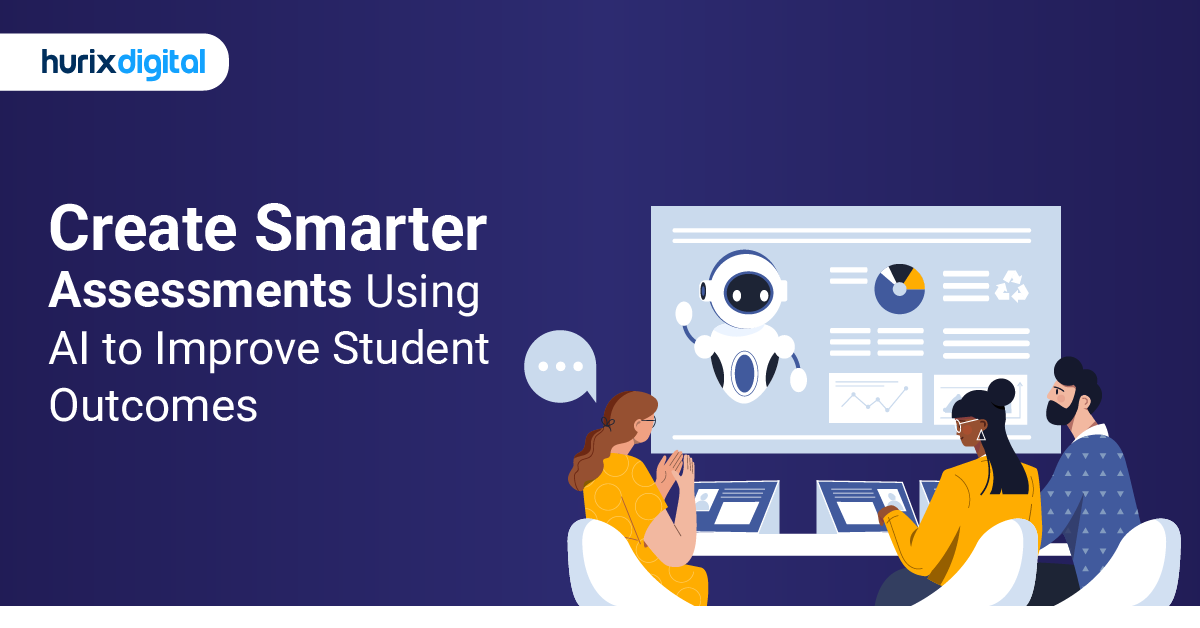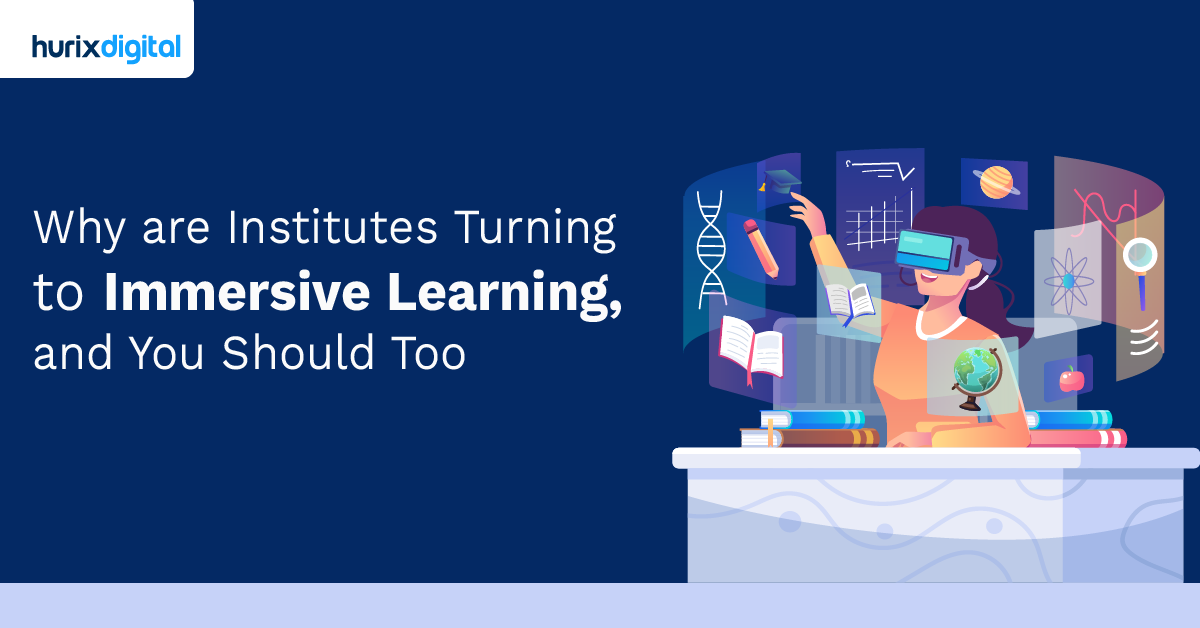
Why are Institutes Turning to Immersive Learning, and You Should Too!
Summarize with:
Technological advancements have significantly reshaped modern education, leaving no aspect of teaching and learning untouched. Among these advancements, integrating immersive learning modules into classrooms stands out.
Immersive tools are certain to completely change how educational technology (EdTech) is used in the classroom, creating a more dynamic and engaged learning environment.
Immersive learning technologies like virtual reality (VR), augmented reality (AR), and 360-degree videos are becoming more popular by the day, providing teachers with adequate resources to enhance their students’ learning journeys.
According to Statista, the Metaverse Education market will grow at a compound annual growth rate (CAGR) of 43.76% between 2023 and 2030, resulting in a projected market volume of 24.7 billion US dollars by 2030. This statistic underlines the growing recognition of immersive learning’s potential impact on education.
In this blog, we’ll explore a few key reasons why schools, colleges, and universities should consider embracing this transformative approach to education. But let’s first grasp the essence of immersive learning.
Table of Contents:
- What is Immersive Learning?
- What is Blended Learning?
- Immersive vs. Blended Learning: What are the Main Differences?
- Reasons Behind the Growing Impact of Immersive Simulations in Education
- Six Reasons to Invest in Immersive Learning Modules
- Summing Up
What is Immersive Learning?
Immersive learning involves integrating the physical world with a simulated or digital realm, enabling users to access content in any direction. The two predominant immersive technologies are virtual reality (VR) and augmented reality (AR).
In VR, simulations empower students to conduct experiments in a risk-free environment, making education engaging and unique. Conversely, augmented reality (AR) superimposes digital information onto the real world, creating a harmonious blend of the virtual and physical.
Immersive technologies take a hands-on learning approach, boosting overall comprehension while actively nurturing critical thinking and problem-solving skills.
What is Blended Learning?
When educators realized that eLearning wasn’t yielding the desired results, they decided to devise a new training strategy. This is how blended learning (hybrid learning) came into existence.
Blended learning seamlessly integrates the strengths of in-person and digital learning within the same training program, encompassing eLearning modules, virtual classes, in-person training, collaborative exercises through web chats or forums, and more.
Thus, it preserves eLearning advantages—time-saving, cost-effectiveness, and flexibility—while amalgamating them with in-person learning benefits like human interactions, idea-sharing, and motivation.
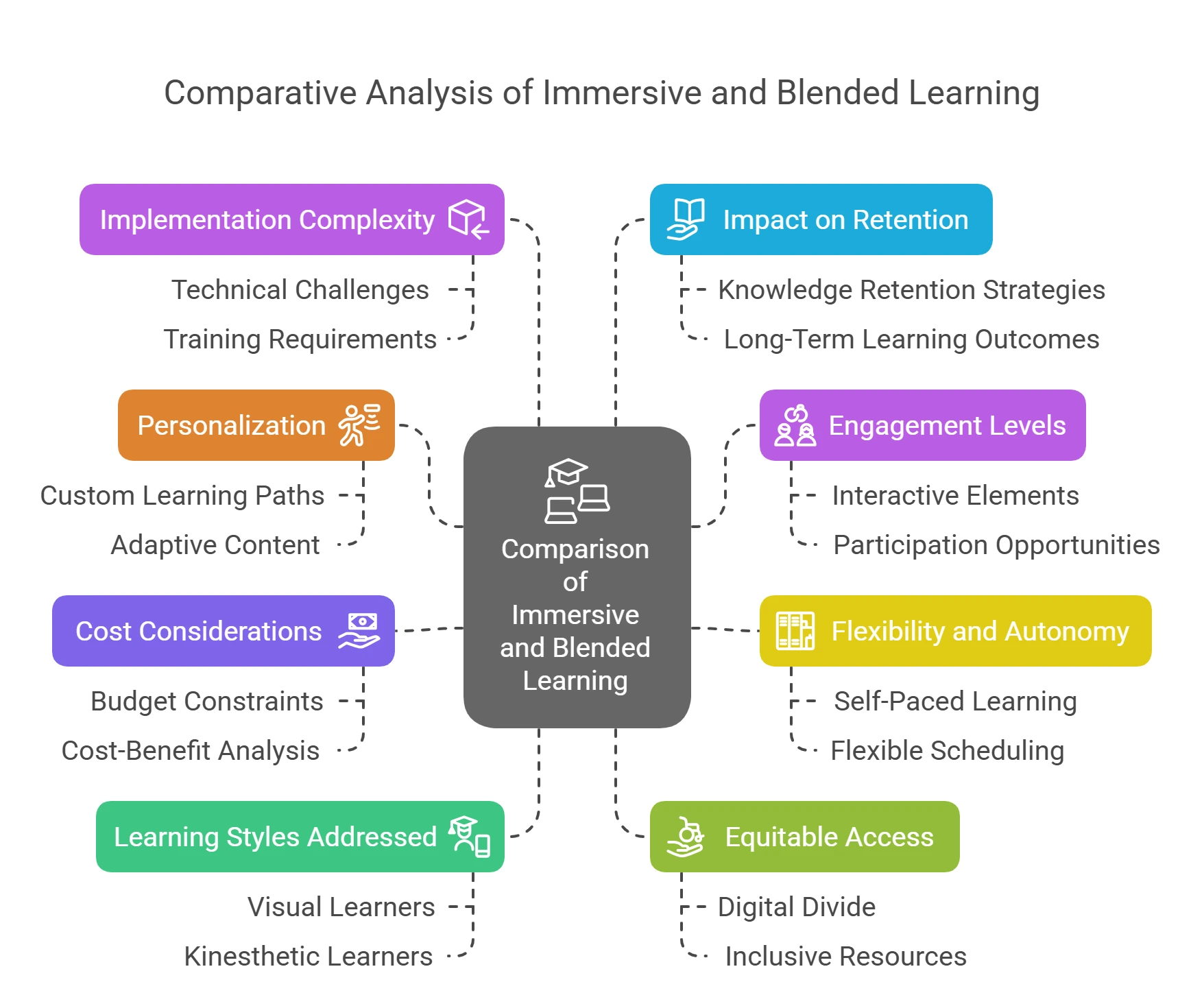
Immersive vs. Blended Learning: What are the Main Differences?
While immersive and blended learning aims to elevate the learner’s experience, there are some stark differences between the two.
Let’s explore some key differences between immersive and blended learning to help you choose the most effective approach for your educational goals.
1. Personalization
With realistic simulations to customize experiences, immersive learning excels at personalized learning it is known to be one of the benefits of immersive learning. Even with the personalization provided by online tools, blended learning might provide less specificity.
While blended learning adjusts through a combination of in-person and virtual encounters, offering variable degrees of personalization, immersive learning fully engages learners with particular skills.
2. Engagement Levels
Immersive environments heighten learner attention through interaction and arousal in realistic scenarios, facilitating a seamless connection between learned skills and real-world applications.
While engagement levels in blended learning may not match immersive learning, they employ diverse methods. In a flipped classroom, students watch online instructional videos, participate in in-person discussions, and engage in interactive simulations with immediate feedback.
Collaborative projects and virtual discussions foster a dynamic and inclusive learning environment that improve peer engagement.
3. Flexibility and Autonomy
While offering a guided experience, immersive learning restricts flexibility in pacing, potentially hindering adaptation to individual learning speeds. This underscores the need to address diverse learning needs within its structure.
Conversely, in blended learning, instructors enjoy greater flexibility in delivering synchronous or asynchronous online instruction and presenting learning resources. Simultaneously, its self-paced nature allows learners to dictate their schedules and choose preferred learning styles.
For instance, learners can autonomously select topics, pace, or formats for online activities and create personalized learning plans or portfolios. Encouraging self-assessment and reflection empowers learners to recognize strengths and areas for improvement.
4. Cost Considerations
The upfront expenses for immersive reality might surpass those of alternative methods, covering hardware, design, programming, and more. While the initial cost challenge of immersive learning may be daunting for leadership teams, it proves cost-effective when training large groups across multiple cycles.
What’s fantastic about blended learning is that it reduces most of the costs that educational institutions or organizations encounter. Educational organizations and schools can save a lot of money with digital learning, from travel costs to renting large spaces for events and printing out learning materials.
5. Learning Styles Addressed
Immersive learning is not restricted to virtual reality (VR) and augmented reality (AR). It accommodates a range of learning preferences, with interactive simulations for kinesthetic learners and auditory components for those who prefer to learn by sound.
Similarly, blended learning caters to the diverse preferences of visual, auditory, kinesthetic, and reading/writing learners. It accomplishes this in several ways by providing students with multimedia presentations, infographics, live discussions, recorded lectures, hands-on exercises, group projects, reading assignments, and written materials.
This ability to cater to individual preferences is one of the most important benefits of blended learning.
6. Equitable Access
Ensuring fair access to immersive learning is challenging due to the need for specialized hardware and software. This may contribute to a digital divide, limiting accessibility for some students and emphasizing the importance of addressing technological disparities.
In a blended learning approach, face-to-face instruction is significantly reduced. Typically, 30% to 70% of the learning occurs online, allowing teachers to broaden their impact and accommodate a larger number of students.
7. Implementation Complexity
Implementing immersive learning requires a high learning curve for educators and institutions. This is because it requires sophisticated integration of advanced technologies. This complex process requires experience and careful planning to fully utilize immersive educational experiences.
Careful planning is needed to overcome the implementation challenges of blended learning, however, it is generally easier to implement. Institutions can gradually integrate digital elements without a drastic overhaul, ensuring a seamless transition and adaptability to evolving educational needs.
8. Impact on Retention
Decades ago, Motorola innovatively introduced robotic guidance concepts to factory workers.
Blindfolded, they navigated an obstacle course guided by positional data and classmates’ instructions, learning from physical feedback. The superior outcomes from this and many other immersive learning experiments show that adults learn best and retain information the most under real-world conditions.
Thanks to its wide range of instruction methods, blended learning has a favorable effect on student retention. It gives flexibility for self-paced learning, engages users with interactive content, and accommodates different learning styles by combining traditional and online elements—all of which boost recall of the material.
A more thorough comprehension is fostered in learners by combining in-person interaction with digital tools that reinforce essential concepts.
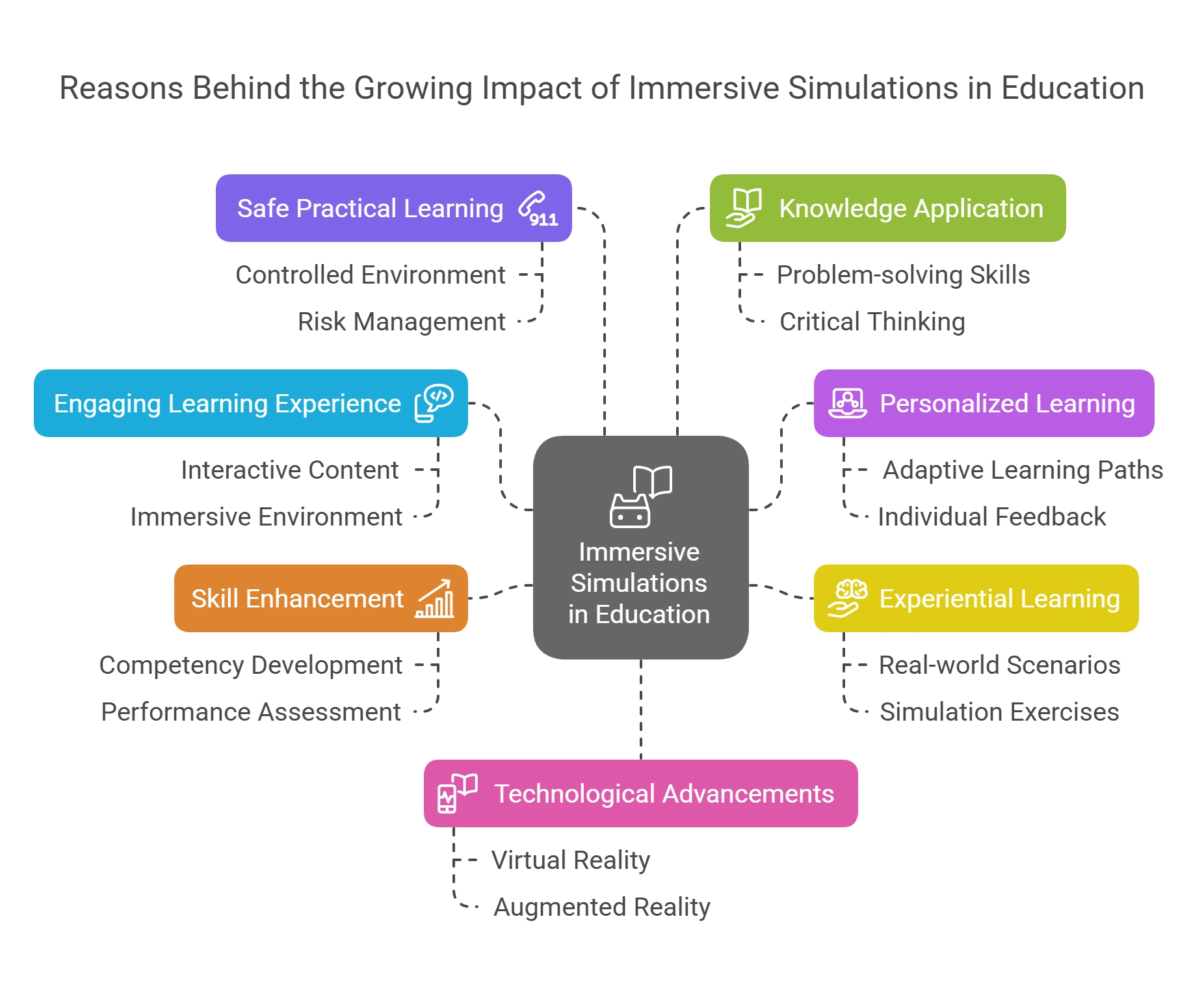
Reasons Behind the Growing Impact of Immersive Simulations in Education
The sphere of education is in flux, and change is the only constant. In this ever-evolving space, the growing impact of immersive simulations becomes evident.
Let us look at some of the reasons behind the emerging significance of immersive simulations in education:
1. Engaging Learning Experience
Immersive education catapults learning into the future. It transforms the conventional methods of teaching, throwing learners into the thick of it to spark interactive problem-solving skills and sharpen focus. Studies show that retention rates soar 75% higher in immersive classrooms.
Well, who would not remember the French Revolution after dodging virtual guillotines? Immersive learning engages multiple senses, facilitating a deeper neural connection to forge stronger memories.
It allows architects to walk through their blueprints before a brick is laid, fostering creative thinking and collaboration, leading learners to where curiosity fuels exploration and discovery becomes the norm.
2. Personalized Learning
Forget one-size-fits-all learning with immersive simulations as it is tailor-made for each learner. Immersive simulations offer a student-centric approach to learning. It is like stepping into a virtual world where the pace, difficulty, and even content are in sync with the unique strengths and preferences of learners.
With immersive simulations, students become the architects of their education, customizing the pace of their courses. Personalized learning within immersive environments dramatically improves engagement and motivation.
It makes learning a thrilling quest rather than a boring chore. With immersive simulations in the mix, each student can absorb, engage, and succeed at a rhythm that suits their individual needs and aspirations.
3. Experiential Learning
The days of passive note-taking are long gone. The increasing significance of immersive learning is a testament to the paradigm shift from passive learning to active exploration.
Immersive simulations propel learners into dynamic environments where theoretical concepts come alive, moving out of the confines of the classroom. Students become active participants, engaging multiple senses and forging lasting connections with the subject matter rather than passively observing.
Learners who are trained through VR are 40% more confident in skill application than their classroom counterparts.
This shift from passive absorption to hands-on exploration enhances retention and deepens understanding, resulting in an educational experience that transcends rote memorization, fostering critical thinking and problem-solving skills.
4. Skill Enhancement
Immersive simulations are no longer a futuristic novelty in a world that demands adaptable and skilled individuals. They have become invaluable tools for equipping future generations with the hands-on expertise they need to thrive.
This iterative practice builds confidence and mastery, facilitating skill development to new heights. Immersive simulations allow students to practice and experiment in life-like situations, resulting in them performing 4x faster than classroom learners.
5. Safe Practical Learning
Staying on top of new skills, enhancing current abilities, and going through compliance training is a constant in every job.
Especially in industries like manufacturing, healthcare, or construction, where things can get pretty hands-on, and technical practice is a must. Education for students wanting to enter these industries must incorporate immersive simulations to help them practice and get firsthand experience.
New doctors often find themselves in situations where their textbook knowledge is insufficient for preparation. It is nerve-wracking! Immersive learning allows one to practice tricky scenarios without real-world consequences.
In medicine, it could mean tackling complex cases before one is face-to-face with a patient. It helps students learn from their mistakes. Immersive simulations bridge the gap between theory and application.
6. Knowledge Application
The emerging significance of immersive simulations in education stems from their unparalleled scope for knowledge application. Unlike traditional methods, immersive technology enables students to apply theoretical concepts in realistic scenarios to foster a deep understanding of subjects.
From science experiments to historical reenactments, learners actively engage with and manipulate information, transcending passive learning. Such an approach cultivates practical skills necessary for real-world challenges.
As the demand for applicable knowledge intensifies, immersive simulations become a pivotal tool to enter the future of learning into a realm where theoretical understanding seamlessly transforms into practical proficiency.
7. Technological Advancements
The sky-rocketing importance of immersive learning in education is intricately tied to technological advancements that keep the education system dynamically up-to-date.
These simulations leverage cutting-edge technology to provide real-time feedback, eradicating delays in comprehension. It eliminates the risk of biases from educators, ensuring an objective learning experience.
Additionally, technological strides ensure accuracy and prevent errors in the educational process. The technology of immersive simulations ushers us into an era of precision, objectivity, and adaptability, making it an indispensable asset in modern education.
Check Out EXCLUSIVE: Hurix Minibook: Immersive Learning for the WIN in Education!
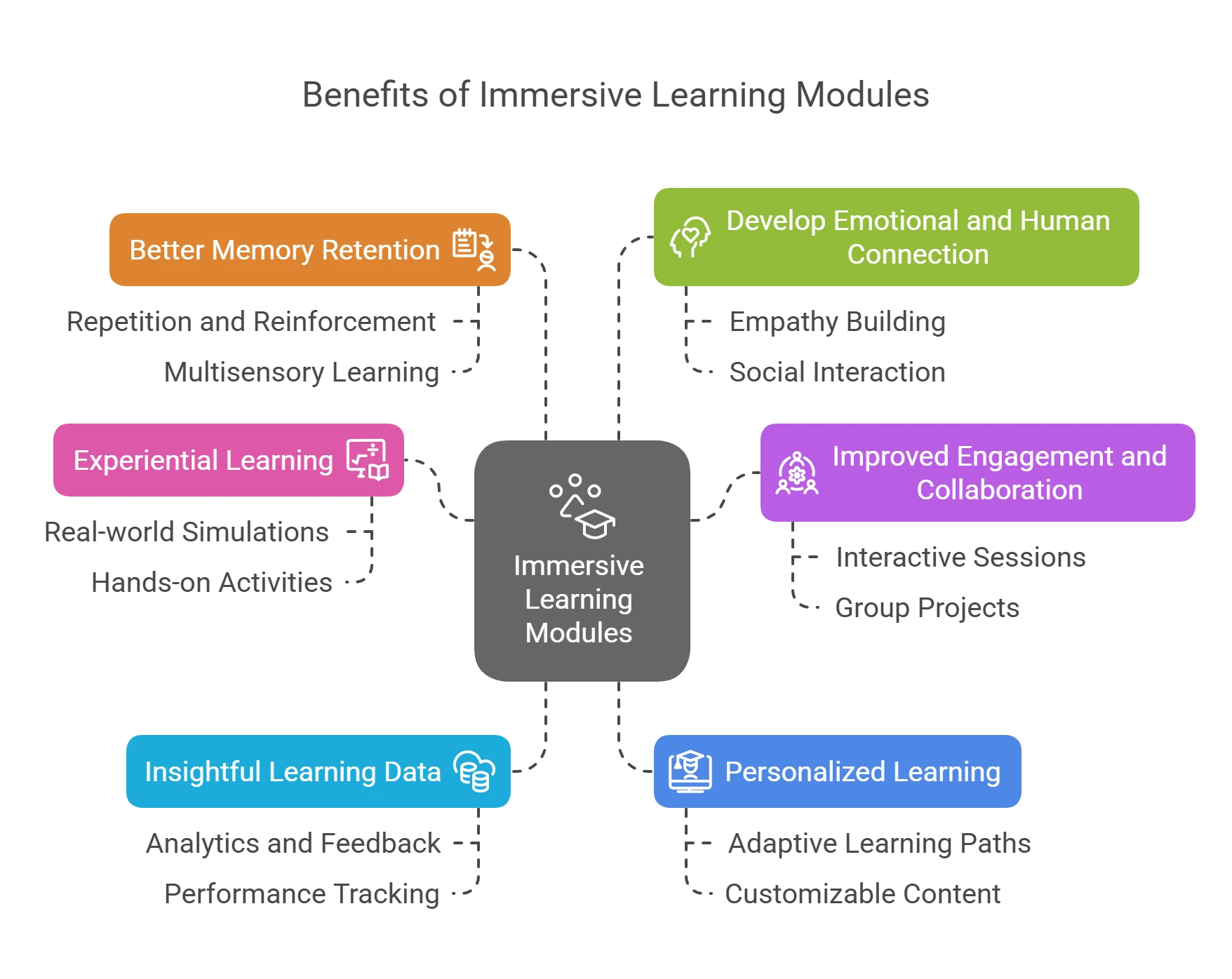
Six Reasons to Invest in Immersive Learning Modules
Immersive learning incorporates visual, kinesthetic, and aural or auditory learning into traditional disciplines. Integrating immersive learning modules into traditional classroom teaching can offer numerous benefits, including learner engagement and improved knowledge retention.
Let’s look at some of the major points of impact, exploring the benefits of immersive learning in classroom education in detail:
1. Experiential Learning
Humans learn best through self-directed and experiential learning. Our understanding deepens when we engage in active participation and experimentation. This vibrant departure from the monotonous listening of subject matter presentations or completing assignments in a traditional homework style transforms learning into an adventure.
Immersive learning emerges as one of the most effective strategies to integrate a learning-by-doing approach into curriculum programs.
For instance, numerous Learning and Development (L&D) teams incorporating Virtual Reality (VR) into their training programs create simulations guiding learners through specific events, allowing them to make decisions and explore different outcomes.
Interactive simulations empower students to learn by doing rather than passive observation, whether customized or ready-to-use. If mistakes occur, students can repeat the simulation until they achieve the desired outcome, ensuring a comprehensive understanding of the concepts.
2. Improved Engagement and Collaboration
Maintaining student involvement in traditional classrooms can be difficult, especially in this day and age when attention spans are getting shorter. Immersive learning modules address this problem by providing an engaging and collaborative learning environment.
For example, students can explore historical sites, ecosystems, or even space without ever leaving their computers thanks to virtual field trips.
VR and AR technologies enable learners to collaborate and engage with peers and teachers through immersive virtual meetings, interactive brainstorming sessions, and shared virtual workspaces. Virtual avatars and non-verbal cues in immersive VR enhance communication, creating lifelike interactions that simulate face-to-face experiences.
Lastly, integrating gamification elements like points, rewards, and leaderboards into the VR environment encourages individuals to get involved, collaborate, and share ideas.
3. Insightful Learning Data
Metrics in VR learning, covering progress, repetition, training time, and even eye and body movement, offer instructors a comprehensive toolset to evaluate each learner and offer personalized feedback. Furthermore, instructors can identify patterns in learning data and use them to change their curriculum to achieve better long-term results.
Learning data can be collected in real-time in VR. Due to time and resource constraints, instructors often find it challenging to gather this detailed information in traditional classroom or e-learning settings.
Hence, immersive technology emerges as a compelling choice for institutions seeking more efficient ways to gauge the effectiveness of their learning programs.
4. Personalized Learning
Given its rising popularity, personalized learning experiences will be one of the most prominent learning trends.
Immersive learning tech stands out because it can be tailored to individual student needs, interests, and learning styles. Adaptive immersive learning modules powered by AR/VR technologies can assess a student’s progress in real-time.
Using this data, they dynamically adjust the difficulty level or pace of the learning module and even provide tailored feedback to address a student’s specific learning needs.
Consider, for example, a language learning application employing AR to create immersive scenarios where students engage with virtual native speakers, refining their language skills within a realistic context. Likewise, VR simulations can cater to diverse skill levels in subjects like mathematics or chemistry, enabling students to advance at their own pace.
5. Better Memory Retention
Typically, individuals are less likely to form strong memory connections when reading or hearing about something than actively experiencing it. That’s where immersive learning steps in, offering a deeper understanding.
Think about it like having a front-row seat to different angles and perspectives. When you get hands-on experience, touch, move stuff around, and dig into how things work, it’s like making memories that come pretty close to the real deal.
According to recent research, VR learning demonstrated a retention rate of 75%, significantly surpassing the rates observed in lecture-style learning (5%) and reading (10%).
6. Develop emotional and Human Connection
Immersive educational technologies, such as VR, are crucial in re-establishing the emotional and human connections often absent in traditional classroom learning and e-learning.
VR learners exhibit a 3.75 times greater emotional connection to the learning content compared to their classroom-style counterparts, primarily due to the immersive and meaningful experiences offered through simulation-based learning.
In the virtual realm, group training sessions promote connection and collaboration among team members, even if they are scattered globally.
In contrast, video conferencing tools and other 2D mediums often fall short of providing this spatial and emotional connection.
Summing Up
Immersive technologies are becoming more affordable and effective every day, moving from niche to mainstream. The widespread adoption of these technologies will reshape the educational landscape, ushering in an era where hands-on, personalized learning experiences are not just the future but a present-day reality.
Educational institutions that invest in immersive learning will be well-positioned to provide their students with dynamic, engaging, and highly effective learning environments, preparing them for the challenges and opportunities of the interconnected world.
Learn more about immersive learning technologies and how Hurix Digital’s adaptive Higher Education and K12 Content Solutions can help you create the perfect learning environment for your students to enhance their knowledge and understanding.
Contact us today to embark on a transformative, immersive learning journey!
Summarize with:

Senior Vice President – Business Development
at Hurix Digital, with over 25 years of experience in EdTech and workforce learning. He excels in business development, customer relationship management, and scaling digital learning solutions, driving global growth through innovative content, simulations, and AI‑driven training offerings
 Upcoming Masterclass | Build an Army of Brand Evangelists using Training & Development | November 20th, 8:30 AM PDT | 11:30 AM EDT | 10:00 PM IST
Upcoming Masterclass | Build an Army of Brand Evangelists using Training & Development | November 20th, 8:30 AM PDT | 11:30 AM EDT | 10:00 PM IST



